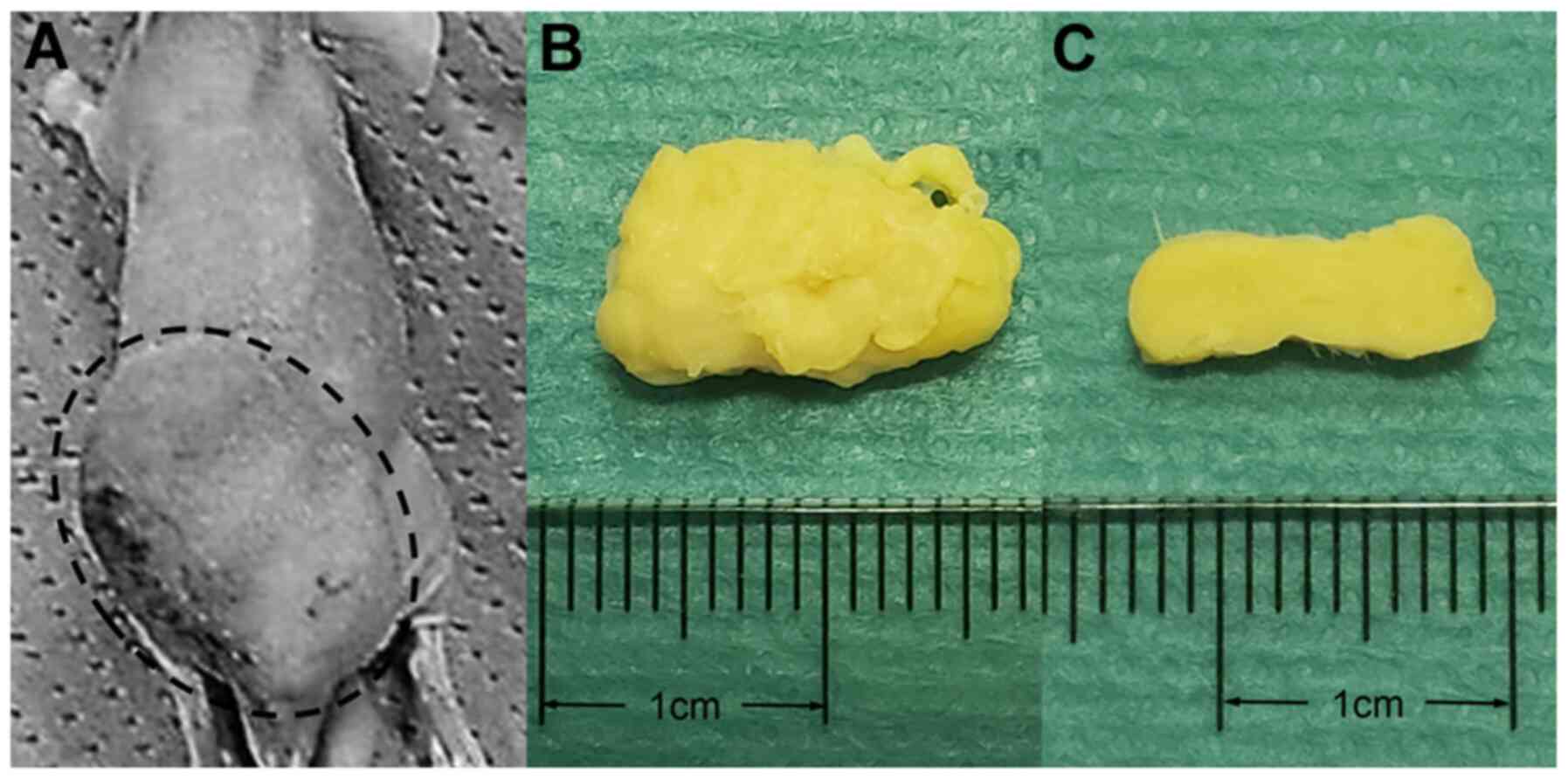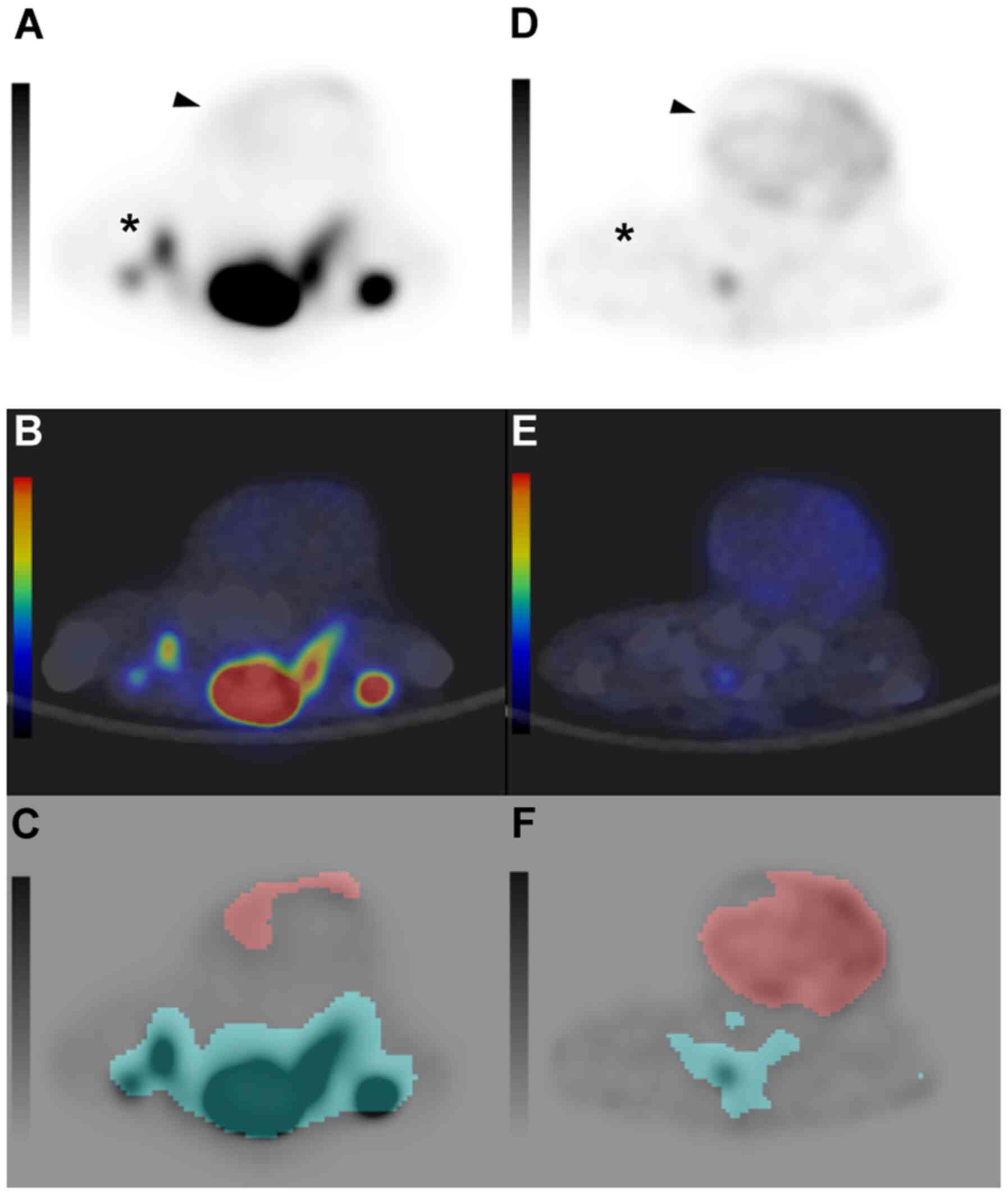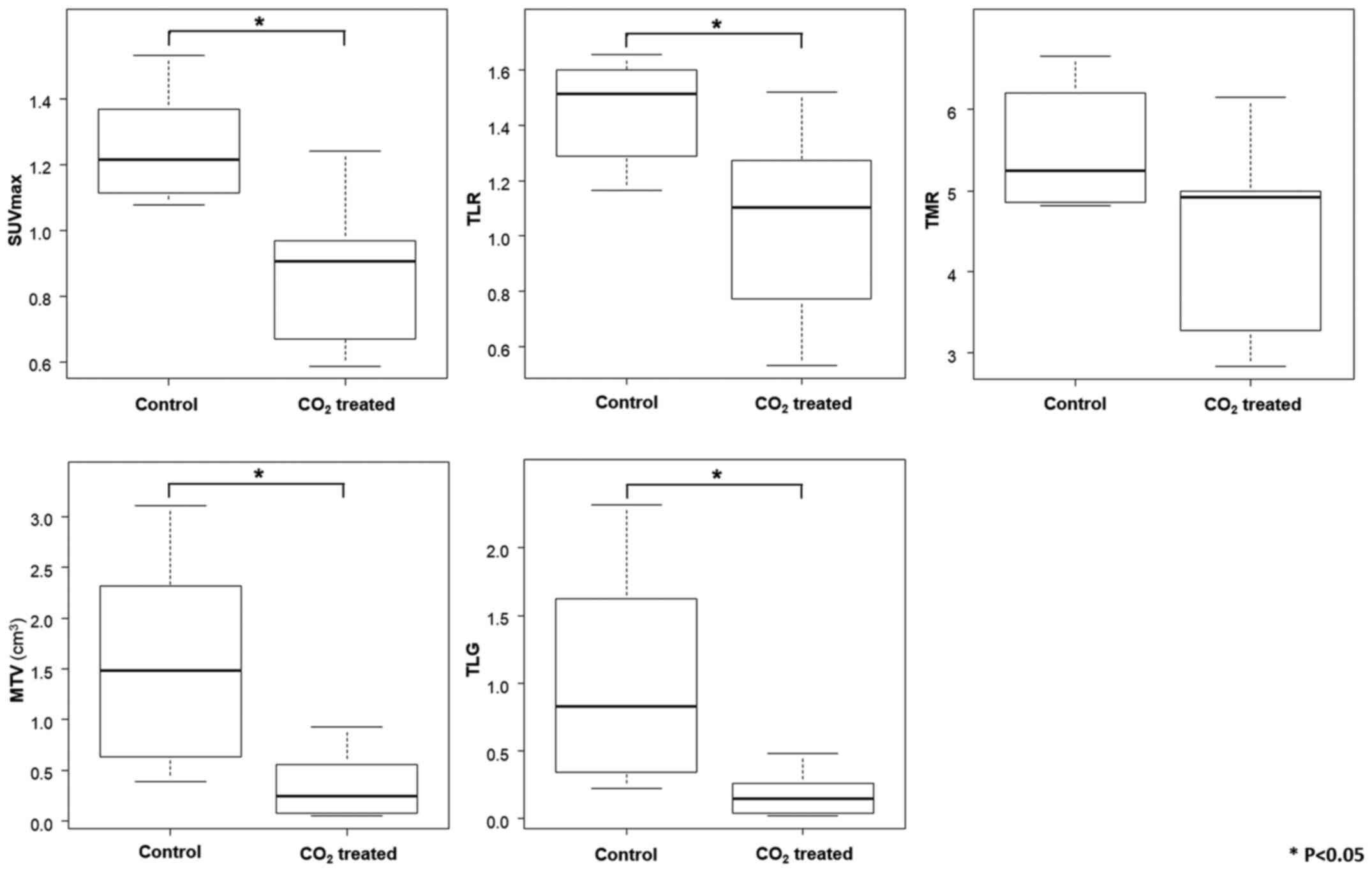|
1
|
Laking G and Price P: Radionuclide imaging
of perfusion and hypoxia. Eur J Nucl Med Mol Imaging. 37 (Suppl
1):S20–S29. 2010. View Article : Google Scholar : PubMed/NCBI
|
|
2
|
Vaupel P: The role of hypoxia-induced
factors in tumor progression. Oncologist. 9 (Suppl 5):10–17. 2004.
View Article : Google Scholar : PubMed/NCBI
|
|
3
|
Jensen FB: Red blood cell pH, the Bohr
effect, and other oxygenation-linked phenomena in blood
O2 and CO2 transport. Acta Physiol Scand.
182:215–227. 2004. View Article : Google Scholar : PubMed/NCBI
|
|
4
|
Mimeault M and Batra SK: Hypoxia-inducing
factors as master regulators of stemness properties and altered
metabolism of cancer- and metastasis-initiating cells. J Cell Mol
Med. 17:30–54. 2013. View Article : Google Scholar : PubMed/NCBI
|
|
5
|
Hartmann BR, Bassenge E, Pittler M and
Hartmann BR: Effect of carbon dioxide-enriched water and fresh
water on the cutaneous microcirculation and oxygen tension in the
skin of the foot. Angiology. 48:337–343. 1997. View Article : Google Scholar : PubMed/NCBI
|
|
6
|
Liang J, Kang D, Wang Y, Yu Y, Fan J and
Takashi E: Carbonate ion-enriched hot spring water promotes skin
wound healing in nude rats. PLoS One. 10:e01171062015. View Article : Google Scholar : PubMed/NCBI
|
|
7
|
Sakai Y, Miwa M, Oe K, Ueha T, Koh A,
Niikura T, Iwakura T, Lee SY, Tanaka M and Kurosaka M: A novel
system for transcutaneous application of carbon dioxide causing an
‘artificial Bohr effect’ in the human body. PLoS One. 6:e241372011.
View Article : Google Scholar : PubMed/NCBI
|
|
8
|
Onishi Y, Kawamoto T, Ueha T, Kishimoto K,
Hara H, Fukase N, Toda M, Harada R, Minoda M, Sakai Y, et al:
Transcutaneous application of carbon dioxide (CO2) induces
mitochondrial apoptosis in human malignant fibrous histiocytoma in
vivo. PLoS One. 7:e491892012. View Article : Google Scholar : PubMed/NCBI
|
|
9
|
Harada R, Kawamoto T, Ueha T, Minoda M,
Toda M, Onishi Y, Fukase N, Hara H, Sakai Y, Miwa M, et al:
Reoxygenation using a novel CO2 therapy decreases the
metastatic potential of osteosarcoma cells. Exp Cell Res.
319:1988–1997. 2013. View Article : Google Scholar : PubMed/NCBI
|
|
10
|
Ueshima E, Yamaguchi M, Ueha T, Muradi A,
Okada T, Idoguchi K, Sofue K, Akisue T, Miwa M, Fujii M, et al:
Inhibition of growth in a rabbit VX2 thigh tumor model with
intraarterial infusion of carbon dioxide-saturated solution. J Vasc
Interv Radiol. 25:469–476. 2014. View Article : Google Scholar : PubMed/NCBI
|
|
11
|
Katayama N, Sugimoto K, Okada T, Ueha T,
Sakai Y, Akiyoshi H, Mie K, Ueshima E, Sofue K, Koide Y, et al:
Intra-arterially infused carbon dioxide-saturated solution for
sensitizing the anticancer effect of cisplatin in a rabbit VX2
liver tumor model. Int J Oncol. 51:695–701. 2017. View Article : Google Scholar : PubMed/NCBI
|
|
12
|
Dubois L, Landuyt W, Haustermans K, Dupont
P, Bormans G, Vermaelen P, Flamen P, Verbeken E and Mortelmans L:
Evaluation of hypoxia in an experimental rat tumour model by
[(18)F]fluoromisonidazole PET and immunohistochemistry. Br J
Cancer. 91:1947–1954. 2004. View Article : Google Scholar : PubMed/NCBI
|
|
13
|
Sato J, Kitagawa Y, Yamazaki Y, Hata H,
Okamoto S, Shiga T, Shindoh M, Kuge Y and Tamaki N:
18F-fluoromisonidazole PET uptake is correlated with
hypoxia-inducible factor-1α expression in oral squamous cell
carcinoma. J Nucl Med. 54:1060–1065. 2013. View Article : Google Scholar : PubMed/NCBI
|
|
14
|
Valk PE, Mathis CA, Prados MD, Gilbert JC
and Budinger TF: Hypoxia in human gliomas: demonstration by PET
with fluorine-18-fluoromisonidazole. J Nucl Med. 33:2133–2137.
1992.PubMed/NCBI
|
|
15
|
Onishi Y, Kawamoto T, Ueha T, Hara H,
Fukase N, Toda M, Harada R, Sakai Y, Miwa M, Nishida K, et al:
Transcutaneous application of carbon dioxide (CO2)
enhances chemosensitivity by reducing hypoxic conditions in human
malignant fibrous histiocytoma. J Cancer Sci Ther. 4:72012.
View Article : Google Scholar
|
|
16
|
Watabe T, Kanai Y, Ikeda H, Horitsugi G,
Matsunaga K, Kato H, Isohashi K, Abe K, Shimosegawa E and Hatazawa
J: Quantitative evaluation of oxygen metabolism in the intratumoral
hypoxia: 18F-fluoromisonidazole and 15O-labelled gases
inhalation PET. EJNMMI Res. 7:162017. View Article : Google Scholar : PubMed/NCBI
|
|
17
|
Koyasu S, Tsuji Y, Harada H, Nakamoto Y,
Nobashi T, Kimura H, Sano K, Koizumi K, Hamaji M and Togashi K:
Evaluation of tumor-associated stroma and its relationship with
tumor hypoxia using dynamic contrast-enhanced CT and (18)F
misonidazole PET in murine tumor models. Radiology. 278:734–741.
2016. View Article : Google Scholar : PubMed/NCBI
|
|
18
|
Hirata K, Kobayashi K, Wong KP, Manabe O,
Surmak A, Tamaki N and Huang SC: A semi-automated technique
determining the liver standardized uptake value reference for tumor
delineation in FDG PET-CT. PLoS One. 9:e1056822014. View Article : Google Scholar : PubMed/NCBI
|
|
19
|
Im HJ, Bradshaw T, Solaiyappan M and Cho
SY: Current methods to define metabolic tumor volume in positron
emission tomography: Which one is better? Nucl Med Mol Imaging.
52:5–15. 2018. View Article : Google Scholar : PubMed/NCBI
|
|
20
|
Kanda Y: Investigation of the freely
available easy-to-use software ‘EZR’ for medical statistics. Bone
Marrow Transplant. 48:452–458. 2013. View Article : Google Scholar : PubMed/NCBI
|
|
21
|
Lee ST and Scott AM: Hypoxia positron
emission tomography imaging with 18F-fluoromisonidazole.
Semin Nucl Med. 37:451–461. 2007. View Article : Google Scholar : PubMed/NCBI
|
|
22
|
Krohn KA, Link JM and Mason RP: Molecular
imaging of hypoxia. J Nucl Med. (Suppl 2):49:129S–148S. 2008.
View Article : Google Scholar : PubMed/NCBI
|
|
23
|
Eschmann SM, Paulsen F, Reimold M,
Dittmann H, Welz S, Reischl G, Machulla HJ and Bares R: Prognostic
impact of hypoxia imaging with 18F-misonidazole PET in
non-small cell lung cancer and head and neck cancer before
radiotherapy. J Nucl Med. 46:253–260. 2005.PubMed/NCBI
|
|
24
|
Gagel B, Reinartz P, Demirel C, Kaiser HJ,
Zimny M, Piroth M, Pinkawa M, Stanzel S, Asadpour B, Hamacher K, et
al: [18F] fluoromisonidazole and [18F] fluorodeoxyglucose positron
emission tomography in response evaluation after
chemo-/radiotherapy of non-small-cell lung cancer: A feasibility
study. BMC Cancer. 6:512006. View Article : Google Scholar : PubMed/NCBI
|
|
25
|
Zimny M, Gagel B, DiMartino E, Hamacher K,
Coenen HH, Westhofen M, Eble M, Buell U and Reinartz P: FDG - a
marker of tumour hypoxia? A comparison with [18F]fluoromisonidazole
and pO2-polarography in metastatic head and neck cancer.
Eur J Nucl Med Mol Imaging. 33:1426–1431. 2006. View Article : Google Scholar : PubMed/NCBI
|
|
26
|
Kikuchi M, Yamane T, Shinohara S, Fujiwara
K, Hori SY, Tona Y, Yamazaki H, Naito Y and Senda M:
18F-fluoromisonidazole positron emission tomography
before treatment is a predictor of radiotherapy outcome and
survival prognosis in patients with head and neck squamous cell
carcinoma. Ann Nucl Med. 25:625–633. 2011. View Article : Google Scholar : PubMed/NCBI
|
|
27
|
Asano A, Ueda S, Kuji I, Yamane T,
Takeuchi H, Hirokawa E, Sugitani I, Shimada H, Hasebe T, Osaki A,
et al: Intracellular hypoxia measured by
18F-fluoromisonidazole positron emission tomography has
prognostic impact in patients with estrogen receptor-positive
breast cancer. Breast Cancer Res. 20:782018. View Article : Google Scholar : PubMed/NCBI
|
|
28
|
Mah K and Caldwell CB: Biological target
volume. PET-CT in Radiotherapy Treatment Planning. Paulino AC and
Teh BS: Content Repository Only; Philadelphia: pp. 52–89. 2008,
View Article : Google Scholar
|

















